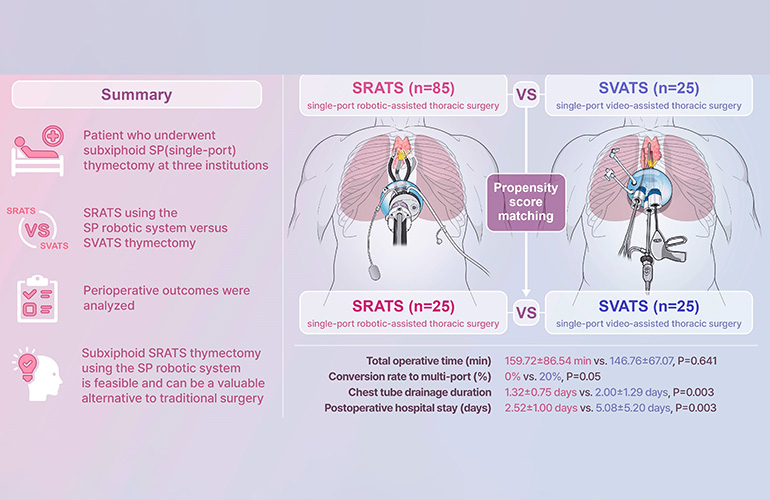|
Listen to this article |
A joint research team from the Department of Thoracic and Cardiovascular Surgery at the Korea University College of Medicine last week announced comparative results of single-port robotic thymectomy using a single-port robotic system.
The team compared and analyzed the perioperative outcomes of 110 cases of robotic thymectomy using the single-port robotic system and conventional video-assisted thoracic surgery (VATS) thymectomy from November 2018 to May 2024. The results showed that all robotic thymectomy performed were successfully performed without conversion to median stenotomy, and 98% of patients had no major complications.
“Through this research, we have an opportunity for our country’s single-port robotic thoracic surgery to be recognized worldwide,” said Prof. Jin-Wook Hwang, a lead author on the paper. “We expect to have greater results from single-port robotic thoracic surgery in the future.”
In addition, compared with VATS thymectomy, conversion rate to multi-port surgery was lower (0%), and the chest tube duration (1.32±0.75 days) and hospitalization period (2.52±1.00 days) were shortened.
“This research proved that single-port robotic thymectomy can overcome the limitations of the conventional thymectomy and provide a better environment,” added Prof. Jun-Hee Lee, lead author on the paper. “We will continue our best to make sure that Korea University Medicine leads the robotic surgery in thoracic surgery.”
Korea University team says results are significant
The entire team included Korea University professors Jun-hee Lee, Hyun-koo Kim, Jin-Wook Hwang, and Jae-Ho Chung. They said the study proved that single-port robotic thymectomy using the single-port robotic system is safer than the conventional VATS thymectomy and can overcome the limitations of the previous method.
“Thoracic surgery departments in three hospitals of Korea University Medicine have come up with very significant results, which successfully shed the light on safety and efficiency of the latest technique of single-port robotic thymectomy,” stated Prof. Jae-Ho Chung. “Based on the results, we will continue our best efforts to related clinical studies and researches, so that single-port robot surgery can be safely applied to more patients who need thoracic surgery.”
The Korea University researchers said they demonstrated that single-port robotic thymectomy provides not only a safer surgical environment for patients, but also opens the possibility of single-port robotic method becoming the standard treatment for thymectomy. This laid the foundation of providing patients with a better treatment experience, they said.
“This research suggested the future possibilities of single-port robotic surgery,” Prof. Hyun-Koo Kim noted. “We will continue exulting our utmost efforts to improve the quality of life of more patients by continuously conducting robotic surgery researches.”
In addition, the research team of the Department of Thoracic and Cardiovascular Surgery, Korea University Medical Center also studied thymectomy, lung cancer surgery, and esophageal cancer surgery via single-port robotic surgery. It performed minimally invasive surgeries using the robotic system not only for thymectomy, but also for lung cancer and esophageal cancer surgeries.
The research results were published in the international academic journal: Cancers (MDPI, Swiss Online Journal Publishing Institute).



